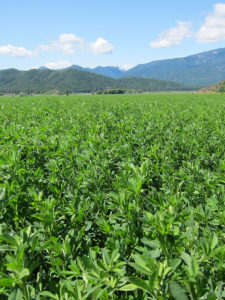 Harvest has come to a close but meeting season is in full swing for the winegrape industry! Several members of the Lodi winegrowing community headed south to fun and beautiful San Luis Obispo, California (SLO) for the tenth annual Sustainable Ag Expo hosted by our coastal friends the Vineyard Team. With so many options for conferences, seminars, and workshops these days, it is hard to know which ones are worth our time and hard-earned money. The Sustainable Ag Expo – held at the infamous Madonna Inn – is one of our favorite grower conferences for the content of the presentations, the quality of the presenters, and the awesome location which lends itself to fantastic networking. At the Expo, presenters tend to stick around during the day and they are very open to conversations, which means free customized advice for the smarter attendees who take advantage of the opportunity. As for networking, you’ll find yourself with many dinner options each and every night – for example, in just one night I enjoyed a delicious happy hour, went to a carnival style harvest party with raw oysters and tables full of outstanding wine, and then headed downtown to cap the night off at a seafood restaurant. If I had to choose only two agricultural conferences to attend each year, one would be Unified and the other would be the Sustainable Ag Expo. Tell us about your favorite conferences and why they are worth it to you in the comments section below!
Harvest has come to a close but meeting season is in full swing for the winegrape industry! Several members of the Lodi winegrowing community headed south to fun and beautiful San Luis Obispo, California (SLO) for the tenth annual Sustainable Ag Expo hosted by our coastal friends the Vineyard Team. With so many options for conferences, seminars, and workshops these days, it is hard to know which ones are worth our time and hard-earned money. The Sustainable Ag Expo – held at the infamous Madonna Inn – is one of our favorite grower conferences for the content of the presentations, the quality of the presenters, and the awesome location which lends itself to fantastic networking. At the Expo, presenters tend to stick around during the day and they are very open to conversations, which means free customized advice for the smarter attendees who take advantage of the opportunity. As for networking, you’ll find yourself with many dinner options each and every night – for example, in just one night I enjoyed a delicious happy hour, went to a carnival style harvest party with raw oysters and tables full of outstanding wine, and then headed downtown to cap the night off at a seafood restaurant. If I had to choose only two agricultural conferences to attend each year, one would be Unified and the other would be the Sustainable Ag Expo. Tell us about your favorite conferences and why they are worth it to you in the comments section below!
 “I enjoy attending the Sustainable Ag Expo to get a recharge on my enthusiasm for sustainable farming after a long harvest. This year’s conference did not disappoint with great discussions on mealybug control, soil nutrition strategies, and the future of a sustainable workforce in California.” – Fourth Generation Farmer David Ogilvie of Wilson Vineyards (LODI RULES certified) & Co-Founder of Muddy Boot Wine
“I enjoy attending the Sustainable Ag Expo to get a recharge on my enthusiasm for sustainable farming after a long harvest. This year’s conference did not disappoint with great discussions on mealybug control, soil nutrition strategies, and the future of a sustainable workforce in California.” – Fourth Generation Farmer David Ogilvie of Wilson Vineyards (LODI RULES certified) & Co-Founder of Muddy Boot Wine
Like a good student, I sat in the front row and took pages of notes to try and remember everything we were learning. I was really impressed by the presenters because they worked hard at giving real-world, short-term advice but very importantly and at the same time, they seemed to understand the more complicated BIG PICTURE. Perhaps it’s because it was a sustainable conference, where people (like the farmers in our LODI RULES program) think about the next 100 years instead of just the next 5.
Based on my notes and many conversations during the conference, below are my TOP TEN take-away messages from this year’s Sustainable Ag Expo, in no particular order.
1. Test for grapevine viruses. Grapevine virus symptoms (such as reddening of leaves) can be very misleading, so testing at a laboratory is CRUCIAL for identification. My new friend, Dr. Marc Fuchs of Cornell University, played a game with the audience where he showed leaves with all sorts of virus-like symptoms and asked us to guess which vines were infected with leafroll or red blotch disease. It was incredible how difficult it was and how easily we were fooled! Dr. Marc Fuchs, Cornell University
2. Pay attention to rootstock. If it is the grapevine rootstock part of a newly planted vine that hosts the virus infection, it may take 2-5 years for the vine to show symptoms. Complicating the situation is that the rootstock mother vines (used as source wood) do not always show virus symptoms when infected. Thus, we need to speak with the CDFA Grapevine Certification program to make sure that all rootstock source wood in California is getting tested as often as possible, and it is important to ask your nursery for recent test results of both scion AND rootstock source material. Dr. Marc Fuchs, Cornell University

Not sure what alfalfa looks like? Here is a photo from the CA Alflafa Forage & Research Foundation.
3. Watch out for the wild ones. Wild grapevines can become infected with viruses just like cultivated grapevines, so if there are wild grapevines near your vineyard you should collect samples and test them – and ask your nursery if they are doing the same. Also watch out for wild and farmed alfalfa, which is home to a red blotch vector insect, the alfalfa treehopper. Dr. Marc Fuchs, Cornell University
4. The new farm worker is older & less flexible. Not long ago the average age of a farm worker was 28. Today it is 39. The number of newcomers (workers who have lived in the US for less than one year) is also down, from 20% to 2%. The new average farm worker now has children and is less flexible and less mobile (and yes, we do mean less flexible in terms of the yoga poses he or she is capable of AND in terms of workplace flexibility such as moving between cities and crops or changing shifts). Dr. Philip Martin, UC Davis
5. The 4 S’s of farm labor. Advice for the current labor situation: satisfy your current workforce with bonuses, high quality 1st level supervision, respect, and good benefits; stretch your current workforce by using mechanical aids to increase efficiency and make the work less taxing on their bodies; substitute human labor with mechanization; and supplement the current workforce with programs such as H2A if it works in your location/situation. Dr. Philip Martin, UC Davis
6. Manage for Stinkwort & Marestail. Stinkwort is a weed that smells like Pine-Sol and many winemakers are hesitant to accept grapes from vineyards with Stinkwort infections. You may think you have Russian thistle, and you can tell the difference because Stinkwort has a yellow flower. Stinkwort germinates as early as March but you won’t really notice it until the summer when it’s too late to properly manage. Treat for Stinkwort with a pre-emergent. Also watch out for and carefully manage Marestail before it grows taller than you because the numerous seeds it produces are wind-blown and can overwinter in you and your neighbor’s vineyards, waiting to drive you guys crazy the next year. John Roncoroni, UCCE Weed Science Farm Advisor
7. Variable rate mechanization equipment is coming soon. Kaan’s team has a trial going on in Galt, CA, where maps of a vineyard block can be downloaded to a piece of mechanization equipment (like a shoot removal machine, for example), so that the equipment can precisely and selectively manage that operation in the vineyard down to an accuracy of 4 inches! In other words, if only a few sections of your vineyard need shoot removal and the rest does not, the machine is intelligent enough to know that. Dr. Kaan Kurtural, UC Oakville Experiment Station
8. SUSTAINABLE mechanization & efficiency. Make sure that your vineyard is set up for mechanization (especially the trellising system and row spacing), and that the mechanization you plan to incorporate is set up for your vineyard. Work with companies that are supported by consumers who are willing to purchase machines, and with companies that support the maintenance of the equipment and it’s technologies. Choose equipment which can be used year-round with technology that is supported and easily serviced. As grape growers, we will need to work with technologies developed in the bigger acreage crops – corn, wheat, soybeans, etc – to ensure reliable equipment in the long-run. Don’t expect mechanization alone to solve the problem of labor shortage. Also do what you can to combine vineyard operations like berm sweeping and mowing as much as possible. Analyze your entire operation to see where going bigger or stronger may save time and money. For example, Jackson Family Wines cut their truck-to-winery turnaround time down to only 12 minutes by using larger presses. They can now process 500-700 tons of grapes in 10 hours with only 2 trucks. Bart Haycraft, Jackson Family Wines
9. Shoot thinning & deficit irrigation. If you aren’t managing irrigation properly, you will be wasting your time with shoot thinning. In a California sprawl vineyard, it is possible to create a dappled light canopy with good air flow and desirable light penetration by coordinating your shoot thinning with deficit irrigation. Another tip for a California sprawl or split canopy vineyard: leaf removal via the roll over method works better than suck and cut or blowing. Dr. Kaan Kurtural, UC Oakville Experiment Station
10. Start composting. The benefits of compost (regenerating soil structure and microbes, less waste going into landfills, etc) were mentioned in several of the presentations and there are many groups willing to teach you how to start composting, either on a small or a large scale. The bottom line: composting is as normal as recycling now and there just isn’t a good reason NOT to do it.
If you missed out on this year’s Sustainable Ag Expo, we hope that you enjoyed these tips. As with any tip, you’ll want to learn more information on your own and evaluate your individual situation to see what works best for you. Save the dates for next year’s Sustainable Ag Expo – November 12-14, 2018. With so many great people now heading down from Lodi, the chances for a LWC beach bonfire one night are high! It’s really important to learn from and with other sustainable winegrowing communities like the Central Coast – going to different winegrowing regions helps our leaders broaden their horizons and think outside the box.

Perhaps this cave will be the site for our 2018 Lodi bonfire at the Sustainable Ag Expo?
Questions? Contact Dr. Stephanie Bolton, Lodi Winegrape Commission, for more information on any of these messages above. You can also check out lots of wonderful educational material on the Vineyard Team’s website, http://www.vineyardteam.org/resources/.
Have something interesting to say? Consider writing a guest blog article!
To subscribe to the Coffee Shop Blog, send an email to stephanie@lodiwine.com with the subject “blog subscribe.”
To join the Lodi Growers email list, send an email to stephanie@lodiwine.com with the subject “grower email subscribe” or click on “join our email list” to the right.
To receive Lodi Grower news and event promotions by mail, send your contact information to stephanie@lodiwine.com or call 209.367.4727.
For more information on the wines of Lodi, visit the Lodi Winegrape Commission’s consumer website, lodiwine.com.

